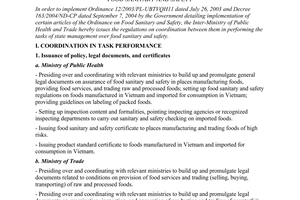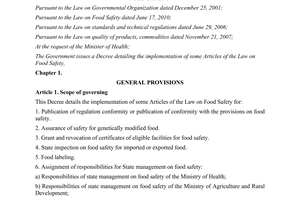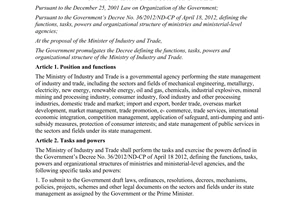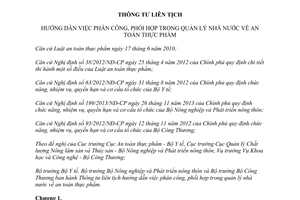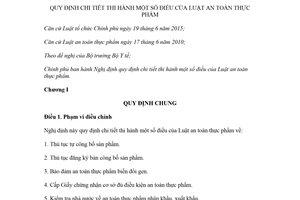Nội dung toàn văn Joint circular No. 13/2014/TTLT-BYT-BNNPTNT-BCT regulatory agencies in food safety management
|
MINISTRY
OF HEALTH- MINISTRY OF AGRICULTURE AND RURAL DEVELOPMENT- MINISTRY OF
INDUSTRY AND TRADE |
SOCIALIST
REPUBLIC OF VIETNAM |
|
Hanoi, April 09, 2014 |
JOINT CIRCULAR
ALLOCATION OF TASKS AND COOPERATION AMONG REGULATORY AGENCIES IN FOOD SAFETY MANAGEMENT
Pursuant to the Law of Food safety dated June 17, 2010;
Pursuant to the Government's Decree No. 38/2012/ND-CP dated April 25, 2012, detailing the implementation of some articles of the Law of Food safety;
Pursuant to the Government's Decree No. 63/2012/ND-CP dated August 31, 2012 defining the functions, tasks, powers and organizational structure of the Ministry of Health;
Pursuant to the Government's Decree No. 199/2013/ND-CP dated November 26, 2013 defining the functions, tasks, powers and organizational structure of the Ministry of Agriculture and Rural Development;
Pursuant to the Government's Decree No. 95/2012/ND-CP dated November 12, 2012, defining the functions, tasks, powers and organizational structure of the Ministry of Industry and Trade;
At the request of the Director of Vietnam Food Administration - The Ministry of Health, the Director of National Agro - Forestry - Fisheries Quality Assurance Department - The Ministry of Agriculture and Rural Development, and the Director or Science and Technology Department - The Ministry of Industry and Trade;
The Minister of Health, the Minister of Agriculture and Rural development, and the Minister of Industry and Trade promulgates a Circular on allocation of tasks and cooperation among regulatory agencies in food safety management.
Chapter 1.
GENERAL PROVISIONS
Article 1. Scope
This Circular deals with:
1. The allocation of tasks and cooperation among regulatory agencies in food safety management.
2. Cooperation in food safety inspection.
3. Validation of knowledge of food safety.
Article 2. Subjects of application
This Circular is applied to:
1. Regulatory agencies in charge of food safety.
2. The organizations and individuals (hereinafter referred to as entities) that manufacture and/or sell food within Vietnam’s territory.
3. Relevant entities.
Chapter 2.
ALLOCATION OF TASKS AND COOPERATION AMONG REGULATORY AGENCIES IN FOOD SAFETY MANAGEMENT
Article 3. Rules for allocation of tasks and cooperation among regulatory agencies in food safety management
1. Each product, each manufacturing facility or trading facility is under the management of only one regulatory agency.
2. Food safety management tasks of regulatory agencies shall be performed in accordance with the lists in the Appendices enclosed with this Circular.
3. If a facility manufactures multiple types of foods that are under the management of two Ministries or more, one of which is the Ministry of Health, it shall be under the management of the Ministry of Health.
4. If a facility manufactures multiple types of foods that are under the management of both the Ministry of Agriculture and Rural Development and the Ministry of Industry and Trade, it shall be under the management of the Ministry of Agriculture and Rural Development.
5. Facilities that sell multiple types of foods that are under the management of two Ministries or more (including markets and supermarkets) shall be under the management of the Ministry of Industry and Trade, except for wholesale markets for agricultural products, which are under the management of the Ministry of Agriculture and Rural Development.
6. The Ministry of Health shall manage the manufacturers of food containers and packages, except for integral containers and packages that are particularly used for food products under the management of the Ministry of Agriculture and Rural Development and the Ministry of Industry and Trade.
7. The Ministry of Health shall take charge and cooperate with the other parties in settling any issue that arises, or send a report to the Prime Minister if necessary.
Article 4. Responsibilities of regulatory agencies for management of food products, food manufacturers and food sellers
1. The Ministry of Health is responsible for food safety management with regard to the food products, manufacturers and sellers of the foods listed in Appendix 1 enclosed herewith and the cases in Clause 3 Article 3; the instruments and materials for wrapping and storing food specified in Clause 6 Article 3 of this Circular.
2. The Ministry of Agriculture and Rural Development is responsible for food safety management with regard to the food products, manufacturers and sellers of the foods listed in Appendix 2 enclosed herewith and the cases in Clause 4 Article 3 of this Circular.
3. The Ministry of Industry and Trade is responsible for food safety management with regard to the food products, manufacturers and sellers of the foods listed in Appendix 3 enclosed herewith and the cases in Clause 5 Article 3 of this Circular.
Chapter 3.
COOPERATION IN FOOD SAFETY INSPECTION
Article 5. Rules for cooperation in food safety inspection
1. Inspections must be carried out based on the functions, tasks, and entitlements of each Ministry.
2. The presiding agency and cooperating agency must be identified:
a) The Ministry of Health, the Ministry of Agriculture and Rural Development, and the Ministry of Industry and Trade shall carry out inspection of food safety according to their given tasks in the Law of Food safety, the Government's Decree No. 38/2012/ND-CP dated April 25, 2012, detailing the implementation of some articles of the Law of Food safety, and this Circular. Relevant Ministries are responsible for cooperation in food safety inspection at the request of the presiding agency or a competent authority.
b) During an interdisciplinary inspection, the Ministry of Health shall take charge and cooperate with the Ministry of Agriculture and Rural Development, the Ministry of Industry and Trade, and forces concerned in organizing and allocating tasks.
3. The inspection must avoid repetition among different levels of authority, ensure a uniform inspection from central to local government. In case an inspection plan is repeated:
a) If the inspection plan of an inferior agency is similar to the inspection plan of a superior agency, the latter shall apply.
b) If the inspection plans of regulatory agencies at the same level are similar, they shall reach an agreement on establishment of an interdisciplinary inspectorate.
4. Regulations of law on principles, expertise, and confidentiality during inspection must be adhered to.
5. The agency that presides over the inspection must send written notifications of the inspection result to the cooperating agencies.
6. Information shall be exchanged between Ministries from planning, execution, to result notification.
7. The issues that arise during the cooperation shall be discussed and settled in accordance with law and requirements of relevant agencies. If a consensus on the issue settlement cannot be reach, a report shall be sent to the Interdisciplinary Food Safety Committee at the same level.
Article 6. Cooperation among central authorities in food safety inspection
1. When an interdisciplinary inspection is necessary, the Ministry of Health shall send a written notification to the Ministry of Agriculture and Rural Development, the Ministry of Industry and Trade, and relevant agencies, requesting them to appoint their units to cooperate in the inspection.
The interdisciplinary inspection plan must specify the contents, location, the presiding agency, and cooperating agency.
2. At the end of an interdisciplinary inspection, every 6 month and every year, the Ministry of Agriculture and Rural Development, the Ministry of Industry and Trade, other Ministries and agencies that participated in the inspectorate shall send reports on results of food safety inspections relevant to their fields or given tasks to the Ministry of Health. The Ministry of Health shall aggregate the reports and send a summary report to Central Interdisciplinary Food Safety Committee and the Prime Minister.
Article 7. Cooperation between central authorities and local authorities in food safety inspection
1. Annually, the Ministry of Health shall take charge and cooperate with the Ministry of Agriculture and Rural Development, the Ministry of Industry and Trade in formulating an interdisciplinary food safety inspection plan.
2. The presiding agency of the central interdisciplinary inspectorate must send written notifications to local Interdisciplinary Food Safety Committee and local food safety authorities for them to:
a) Dispatch officers to the inspectorate, provide information, other resources, and consider the proposals of the central inspectorate;
b) Actively carry out food safety inspection as prescribed or under the guidance of superior authorities.
Article 8. Cooperation among local authorities in interdisciplinary inspection of food safety
1. If an interdisciplinary inspection of food safety is necessary, the Service of Health shall advise the People’s Committee or the Interdisciplinary Food Safety Committee of the province on formulating a plan and implementing it after it is ratified.
2. At the request of the presiding agency, cooperating agencies must dispatch officers to the inspection.
3. At the end of an interdisciplinary inspection, every 6 month and every year, the Service of Agriculture and Rural Development, the Service of Industry and Trade, other Services and agencies that participated in the inspectorate shall send reports on results of food safety inspections relevant to their fields or given tasks to the Service of Health. The Service of Health shall send a summary report to Provincial Interdisciplinary Food Safety Committee and President of the People’s Committee of the province.
4. Statements and provision of information for the press must comply with regulations of law on statements and information provision.
Chapter 4.
VALIDATION OF KNOWLEDGE OF FOOD SAFETY
Article 9. Entitlement to validate knowledge of food safety.
Vietnam Food Administration - The Ministry of Health, National Agro - Forestry - Fisheries Quality Assurance Department - The Ministry of Agriculture and Rural Development shall validate knowledge about food safety of central and local agencies under their management. The agency that issued the Certificate of food safety shall issue the Certificate of food safety knowledge validation to the same recipient.
The Department of Science and Technology - The Ministry of Industry and Trade shall advise the Minister of Industry and Trade on appointing the agencies and units specialized in the food industry to verify knowledge of food safety.
Article 10. Application for Certificate of food safety knowledge validation.
The facility owner and the person that directly works with food shall submit an application for the Certificate of food safety knowledge validation to the same recipient to the agency mentioned in Article 9 of this Circular, whether directly or by post.
Composition of an application:
1. If the applicant is an organization:
a) A written request for validation of knowledge of food safety (form 01a in Appendix 4 enclosed herewith);
b) A list of the applicants for validation of knowledge of food safety (form 01b in Appendix 4 enclosed herewith).
c) A copy of the Certificate of Business registration or Certificate of operation of the branch/representative office, or a Certificate of cooperative registration (bearing the seal of the tc0.
d) Receipts for fee payment in accordance with regulations of law on fees and charges.
2. If the applicant is an individual:
a) A written request for validation of knowledge of food safety (form 01a in Appendix 4 enclosed herewith);
b) A copy of the ID card;
c) Receipts for fee payment in accordance with regulations of law on fees and charges.
Article 11. Procedures for validation of knowledge of food safety.
1. Within 10 working days from the day on which the satisfactory application is received, a plan for validation of knowledge of food safety shall be made and the applicant shall be notified of the time for validation of knowledge of food safety.
2. Knowledge of food safety shall be tested by the questions about food safety related to the applicant’s field.
3. The Certificate of food safety knowledge validation safety shall be issued to the applicants that correctly answer at least 80% of the questions about overall knowledge and at least 80% of the questions about professional knowledge. Within 30 working days from the examination date, the agency mentioned in Article 9 of this Circular shall issue Certificates. The template of the Certificate of food safety knowledge validation is provided in form 02a of Appendix 4 enclosed herewith.
Article 12. Management of Certificates of food safety knowledge validation
1. A Certificate of food safety knowledge validation is valid for 03 years from is date of issue.
2. Individuals that have had their food safety knowledge validated shall be recognized when they work at facilities that manufacture or sell corresponding products.
Article 13. Food safety knowledge and questions about food safety knowledge
1. Food safety knowledge includes overall knowledge and professional knowledge of food safety.
2. Overall knowledge of food safety include: regulations of law on food safety; threats to food safety; food safety conditions, methods of ensuring food safety; food safety practice.
3. Vietnam Food Administration - The Ministry of Health, National Agro - Forestry - Fisheries Quality Assurance Department - The Ministry of Agriculture and Rural Development, and Science and Technology Department - The Ministry of Industry and Trade shall compile and issue the documents mentioned in Clause 1 and Clause 2 of this Article, and the questions about food safety knowledge of each Ministry.
4. If some tasks are repeated, Vietnam Food Administration - The Ministry of Health shall take charge and cooperate with National Agro - Forestry - Fisheries Quality Assurance Department - The Ministry of Agriculture and Rural Development and Science and Technology Department - The Ministry of Industry and Trade in compiling documents and the questions.
Chapter 5.
IMPLEMENTATION
Article 14. Effect
This Circular takes effect on May 26, 2014.
The regulations in the Circular No. 16/2005/TTLT-BYT-BCN dated May 20, 2005 of the Ministry of Health and the Ministry of Industry on allocation of tasks and cooperation among regulatory agencies in management of food safety and hygiene; the Circular No. 24/2005/TTLT/BYT-BTS dated December 08, 2005 of the Ministry of Health and the Ministry of Fisheries on allocation of tasks and cooperation among regulatory agencies in management of food safety and hygiene applied to aquaculture products; the Circular No. 01/2006/TTLT/BYT-BNN dated January 04, 2006 of the Ministry of Agriculture and Rural Development on allocation of tasks and cooperation in management of food safety and hygiene; and the Circular No. 18/2005/TTLT/BYT-BTM dated July 12, 2005 of the Ministry of Health and the Ministry of Trade on cooperation among regulatory agencies in management of food safety and hygiene are abrogated.
Article 15. Implementation organization
Vietnam Food Administration - The Ministry of Health, National Agro - Forestry - Fisheries Quality Assurance Department - The Ministry of Agriculture and Rural Development, and Science and Technology Department - The Ministry of Industry and Trade shall inspect and supervise the implementation of this Circular.
Any difficulty that arises during the implementation of this Circular should be reported to the Ministry of Health (Vietnam Food Administration), the Ministry of Agriculture and Rural Development (National Agro - Forestry - Fisheries Quality Assurance Department), or the Ministry of Industry and Trade (Science and Technology Department) for consideration./.
|
PP THE MINISTER OF INDUSTRY AND TRADE |
PP THE MINISTER OF AGRICULTURE AND
RURAL DEVELOPMENT |
PP THE MINISTER OF HEALTH |
APPENDIX 1
LIST OF FOOD PRODUCTS, GROUPS OF FOOD PRODUCTS, AND GOODS UNDER THE MANAGEMENT OF THE MINISTRY OF HEALTH
|
No. |
Name of product/group of products |
Notes |
|
1 |
Bottled water |
|
|
2 |
Mineral water |
|
|
3 |
Functional foods |
|
|
4 |
Supplementary micronutrients and micronutrient-fortified foods |
|
|
5 |
Food additives |
|
|
6 |
Flavorings |
|
|
7 |
Food processing aids |
|
|
8 |
Instruments and materials for wrapping and storing food |
Except for those under the management of the Ministry of Agriculture and Rural Development and the Ministry of Industry and Trade that are manufactured by the same facility for internal use only |
|
9 |
Consumable ice (instant ice and ice used for food processing) |
Except for ice used for preservation, processing of products under the management of the Ministry of Agriculture and Rural Development |
|
10 |
Other products not enumerated in the list of the Ministry of Industry and Trade and the Ministry of Agriculture and Rural Development |
|
APPENDIX 2
LIST OF FOOD PRODUCTS, GROUPS OF FOOD PRODUCTS, AND GOODS UNDER THE MANAGEMENT OF THE MINISTRY OF AGRICULTURE AND RURAL DEVELOPMENT
|
No. |
Name of product/group of products |
Notes |
|
I |
Cereal |
|
|
1 |
Cereal |
|
|
2 |
Preprocessed, processed cereal (husked, cut, hulled, in pieces, germinated, heated, etc.) |
Except for flour, starch, and products thereof. |
|
II |
Meat and products thereof |
|
|
1 |
Fresh meat, cooled meat, frozen meat (as a whole or cut, sliced, ground, rolled, etc.) |
|
|
2 |
Edible by-products of livestock (offal, bones, legs, necks, wings, fat, blood, etc.) |
|
|
3 |
Products derived from meat and edible by products of livestock and poultry (dried, smoked, canned, heated, cured with salt, collagen, gelatin, etc.) |
Except for functional foods under the management of the Ministry of Health |
|
4 |
Blended products that contain meat (rolls, sausages, salami, sausage, ham, pâté, breaded meats, breaded, treated with oil, soup, juice, extracts, etc.) |
Except for products in the form of cakes under the management of the Ministry of Industry and Trade. |
|
III |
Aquatic animals (hereinafter referred to as fish) and products thereof (including amphibious species) |
|
|
1 |
Live, fresh, cool, frozen fish (whole fish, preprocessed, fillets, ground, rolled, sliced, laminated, etc.) |
|
|
2 |
Edible by-products of fish (skin, fins, bubbles, fat, livers, eggs etc.) |
|
|
3 |
Products of fish and edible by-products of fish (fermented, salted, heated, smoked, dried, brined, breaded, treated with oil, extracts, juices, gelatin, collagen, etc. including chemicals, additives, and processing aids) |
Except for functional foods under the management of the Ministry of Health |
|
4 |
Fat and oil derived from fish, refined or not refined, used as food |
Except for functional foods and medicinal products derived from fish under the management of the Ministry of Health |
|
5 |
Fish products blended with flour, starch, bread, processed milk, vegetable oil (including pawn-crackers, fish-crackers, squid-crackers, etc.) |
Trừ sản phẩm dạng bánh do Bộ Công Thương quản lý. |
|
6 |
Seaweed, algae, and products thereof, used as food |
Except for functional foods derived from seaweed and algae under the management of the Ministry of Health |
|
IV |
Vegetables, tubers, fruits, and products thereof |
|
|
1 |
Fresh and pretreated vegetables, tubers, fruits (cut, hulled, threshed, segmented, ground, etc.) |
Except for vegetables, tubers, fruits, and seeds used for sowing |
|
2 |
Processed vegetables, tubers, fruits (fermented, dried, heated, powdered, canned, breaded, pickled, treated with oil, sugar, extracts, juices, etc.) |
Except for confectionery, dried apricot, and soft drinks under the management of the Ministry of Industry and Trade |
|
V |
Eggs and products thereof |
|
|
1 |
Eggs of terrestrial and amphibious animals |
|
|
2 |
Preprocessed or processed eggs of terrestrial and amphibious animals (peeled, molded, frozen, fine ground, heated, salted, cured with herbs, etc.) |
|
|
3 |
Mixed foods that have eggs, powdered eggs |
Except for confectionery that contains eggs, powdered eggs under the management of the Ministry of Industry and Trade. |
|
VI |
Raw milk |
|
|
VII |
Honey and products thereof |
|
|
1 |
Pure, condensed, diluted honey |
|
|
2 |
Beeswax, pollen, royal jelly with or without honey. |
|
|
3 |
Products that contain honey, beeswax, pollen, royal jelly. |
Except for confectionery, and beverages that contain honey under the management of the Ministry of Industry and Trade. Except for functional foods and medicinal products under the management of the Ministry of Health. |
|
VIII |
Genetically modified foods |
|
|
IX |
Salt |
|
|
1 |
Sea salt, rock salt |
|
|
2 |
Refined salt, processed salt, salt mixed with other ingredients |
|
|
X |
Spices |
|
|
1 |
Single spices, mixed spices, spices derived of animals, plants (flavorings extracted form meat, bones, in powder form, extracts, mustard, etc.) |
Except for flavoring in the same package with starch products (instant noodle, instant porridge, etc.) under the management of the Ministry of Industry and Trade. |
|
2 |
Sauces and preparations for sauces |
|
|
3 |
Sauces |
|
|
4 |
Fruits that belong to Capsicum or Pimenta genus, fresh, dried, ground, or crushed |
|
|
XI |
Sugar |
|
|
1 |
Cane sugar or beet sugar and sucrose, chemically pure, solid. |
|
|
2 |
Other sugars (including lactose, mantose, glucose, and fructose, chemically pure, solid; sugar syrup without flavorings or colorings; artificial honey mixed or not mixed with natural honey; caramel) |
|
|
3 |
Molasses derived from extracting or refining sugar |
|
|
XII |
Tea |
|
|
1 |
Fresh tea, processed tea with or without flavorings |
Except for prepared products in the form of soft drinks; confectionery that contains tea under the management of the Ministry of Industry and Trade. |
|
2 |
Other tea products derived from plants |
Except for prepared products in the form of soft drinks under the management of the Ministry of Industry and Trade. |
|
XIII |
Coffee |
|
|
1 |
Fresh, dried coffee beans, substances extracted and condensed from coffee |
|
|
2 |
Coffee, roasted or not roasted, decaffeinated or not decaffeinated; coffee fruit and pulp; substitutes for coffee that contain certain proportion of coffee; powdered coffee with or without sugar, milk, cream for instant use; processed products that contain coffee |
Except for prepared products in the form of soft drinks; confectionery that contains coffee under the management of the Ministry of Industry and Trade. |
|
XIV |
Cocoa |
|
|
1 |
Fresh, dried cocoa beans, broken or not broken, fresh or roasted; cocoa peel, cocoa pod husk, cocoa pulp, and other cocoa by-products; cocoa paste, defatted or not defatted; cocoa butter, cocoa fat and oil; cocoa powder without sugar or other sweeteners |
|
|
2 |
Products from powder of cocoa that are roasted, not roasted, solid, liquid, flour, for instant use or without sugar, milk, cream; other products that contain cocoa. |
Except for soft drinks; confectionery that contains cocoa under the management of the Ministry of Industry and Trade. |
|
XV |
Pepper |
|
|
1 |
Dried, fresh, ground, crushed pepper (Piper genus) |
|
|
2 |
Fruits that belong to Capsicum or Pimenta, fresh, dried, ground, or crushed |
|
|
XVI |
Cashew |
|
|
1 |
Cashew nuts |
|
|
2 |
Products of cashew nuts |
Except for confectionery that contains cashew nuts under the management of the Ministry of Industry and Trade. |
|
XVII |
Other agricultural products |
|
|
1 |
Seeds (sunflower seeds, pumpkin seeds, watermelon seeds, etc.), processed or unprocessed |
|
|
2 |
Products derived from plant used as food, raw, preprocessed, or processed (bamboo shoots, black fungus, mushrooms; soy products, except for oil; edible bark, roots, leaves, stems, flowers of some plants, etc.) |
Except for those used as herbal ingredients or functional foods under the management of the Ministry of Health |
|
3 |
Bird’s nests and products thereof |
Except for those used as herbal ingredients or functional foods under the management of the Ministry of Health |
|
4 |
Products derived from inspects, used as food (grasshoppers, crickets, caterpillars, etc.) |
|
|
XVIII |
Instruments and materials for wrapping and storing food during manufacture, processing, sale of foods under the management of the Ministry of Agriculture and Rural Development |
|
|
XIX |
Ice for preservation, processing of products under the management of the Ministry of Agriculture and Rural Development. |
|
APPENDIX 3
LIST OF FOOD PRODUCTS, GROUPS OF FOOD PRODUCTS, AND GOODS UNDER THE MANAGEMENT OF THE MINISTRY OF INDUSTRY AND TRADE
|
No. |
Name of product/group of products |
Notes |
|
I |
Beer |
|
|
1 |
Draught beer |
|
|
2 |
Bottled beer |
|
|
3 |
Canned beer |
|
|
II |
Alcohol and alcoholic drinks |
Not including medicinal alcohol under the management of the Ministry of Health. |
|
1 |
Wine |
|
|
1.1 |
Non-carbonated wine |
|
|
1.2 |
Carbonated wine |
|
|
2 |
Fruit wine |
|
|
3 |
Liqueur |
|
|
4 |
Strong wine |
|
|
5 |
White wine, vodka |
|
|
6 |
Other alcoholic drinks |
|
|
III |
Soft drinks |
Not including mineral water and pure water under the management of the Ministry of Health |
|
1 |
Canned beverages, including fruit and vegetable juices. |
|
|
2 |
Soft drinks that need diluting before drinking |
|
|
3 |
Instant soft drinks |
Not including mineral water and pure water under the management of the Ministry of Health |
|
IV |
Processed milk |
Not including micronutrient-enriched products and functional foods under the management of the Ministry of Health |
|
1 |
Liquid milk (including liquid million VND that contain flavorings or other food additives) |
|
|
1.1 |
Pasteurized products |
|
|
1.2 |
Products sterilized by ultra-high-temperature processing or other high-temperature methods. |
|
|
2 |
Fermented milk |
|
|
2.1 |
Liquid |
|
|
2.2 |
Solid |
|
|
3 |
Powdered milk |
|
|
4 |
Condensed milk |
|
|
4.1 |
Sweetened |
|
|
4.2 |
Not sweetened |
|
|
5 |
Cream |
|
|
5.1 |
Pasteurized |
|
|
5.2 |
UHT |
|
|
6 |
Soy milk |
|
|
7 |
Other dairy products |
|
|
7.1 |
Butter |
|
|
7.2 |
cheese |
|
|
7.3 |
Other products from processed milk |
|
|
V |
Vegetable oil |
Not including micronutrient-enriched products and functional foods under the management of the Ministry of Health |
|
1 |
Sesame oil. |
|
|
2 |
Bran oil |
|
|
3 |
Soya-bean oil |
|
|
4 |
Peanut oil |
|
|
5 |
Olive oil |
|
|
6 |
Palm oil |
|
|
7 |
Sunflower seed oil |
|
|
8 |
Rhum oil |
|
|
9 |
Cottonseed oil |
|
|
10 |
Coconut oil |
|
|
11 |
Palm seed oil or babasu oil |
|
|
12 |
Rapeseed oil or mustard oil |
|
|
13 |
Flax oil |
|
|
14 |
Castor oil |
|
|
15 |
Other oils |
|
|
VI |
Flour, starch |
Not including micronutrient-enriched products and functional foods under the management of the Ministry of Health |
|
1 |
Wheat flour of meslin flour |
|
|
2 |
Milled cereal |
|
|
3 |
Potato flour |
|
|
4 |
Malt: roasted or not roasted |
|
|
5 |
Starch: wheat, corn, potato, others |
|
|
6 |
Inulin |
|
|
7 |
Wheat gluten |
|
|
8 |
Products from dough, raw of cooked: spaghetti, macaroni, noodle, instant noodle, flat noodle, gnochi, ravioli, cannelloni, instant porridge, vermicelli, etc. |
|
|
9 |
Products from tapioca and substitutes made of starch, in pieces, grains, fine powder, and the likes |
|
|
VII |
Confectionery |
Not including micronutrient-enriched products and functional foods under the management of the Ministry of Health |
|
1 |
Sweet, salted, or tasteless cookies |
|
|
2 |
Biscuits, baked bread, and the likes |
|
|
3 |
Dough bread |
|
|
4 |
Toast |
|
|
5 |
Birthday cakes |
|
|
6 |
Hard and soft candies with sugar and no cocoa |
|
|
7 |
Chewing gums, coated or not coated with sugar |
|
|
8 |
chocolate |
|
|
9 |
Jam, fruit jelly, powder and paste from fruits or nuts, during cooking process, containing sugar, other sweeteners, or wine. |
|
|
10 |
Fruits, nuts, and other edible parts of plants, treated or otherwise preserved, containing with sugar, other sweeteners, or wine. |
|
|
11 |
Other confectionary products |
|
|
VIII |
Instruments and materials for wrapping and storing food during manufacture, processing, sale of foods under the management of the Ministry of Industry and Trade |
|
------------------------------------------------------------------------------------------------------
This translation is made by LawSoft and
for reference purposes only. Its copyright is owned by LawSoft
and protected under Clause 2, Article 14 of the Law on Intellectual Property.Your comments are always welcomed
